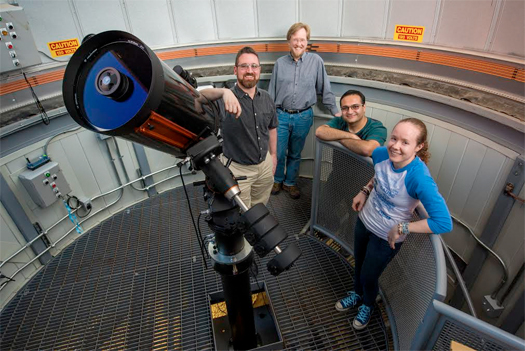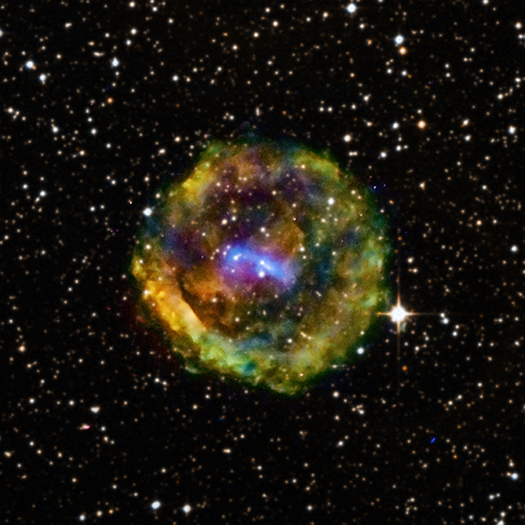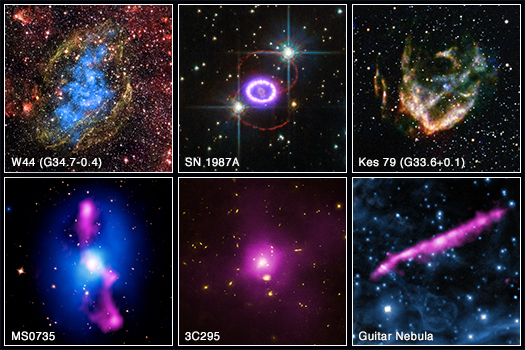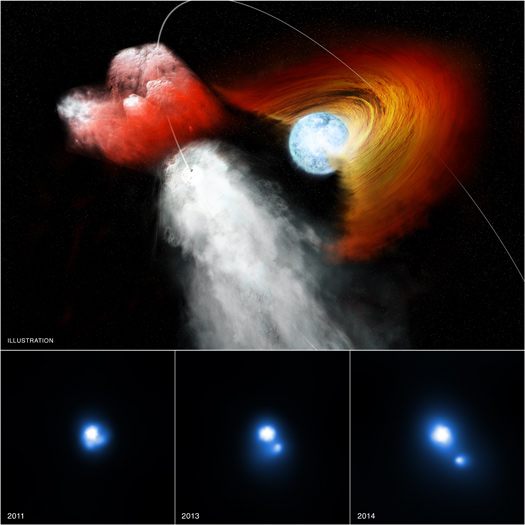Neutron Stars/X-ray Binaries
Supernova Ejected from the Pages of History
A new look at the debris from an exploded star in our galaxy has astronomers re-examining when the supernova actually happened. Recent observations of the supernova remnant called G11.2-0.3 with NASA's Chandra X-ray Observatory have stripped away its connection to an event recorded by the Chinese in 386 CE.
Tracking Down a Stealthy Black Hole
We are pleased to welcome Bailey Tetarenko as our guest blogger. She is the lead author on a paper featured in our latest press release about a possible new population of black holes in the Galaxy. Bailey received her undergraduate degree in Astrophysics at the University of Calgary and then a master’s in Physics at the University of Alberta in 2014. She is now two years into her Ph.D. in Physics at the University of Alberta, where she is studying the black hole population of the Milky Way.

From right to left Bailey Tetarenko, Dr. Arash Bahramian and Dr. Craig Heinke and Dr. Greg Sivakoff. Credit: John Ulan
For fans of black holes, we live in exciting times. Nearly all of our empirical knowledge about stellar mass black holes – that is, black holes weighing about 5 to 35 times the mass of the sun – comes from black hole X-ray binary systems. In these systems a black hole pulls in material from a nearby companion star, causing the system to become very bright in X-rays. But, recently gravitational waves have been detected from pairs of distant black holes that emit no electromagnetic radiation (a.k.a. all forms of light). And now, my team's work suggests that there are many black hole X-ray binaries in our own Milky Way that emit relatively little X-rays.
What Spawned the Jellyfish Nebula?
The Jellyfish Nebula, also known by its official name IC 443, is the remnant of a supernova lying 5,000 light years from Earth. New Chandra observations show that the explosion that created the Jellyfish Nebula may have also formed a peculiar object located on the southern edge of the remnant, called CXOU J061705.3+222127, or J0617 for short. The object is likely a rapidly spinning neutron star, or pulsar.
Banking X-ray Data for the Future
Archives, in their many forms, save information from today that people will want to access and study in the future. This is a critical function of all archives, but it is especially important when it comes to storing data from today's modern telescopes.
A Disk-Shattering Discovery

Jeremy Hare
We are very pleased to welcome Jeremy Hare as a guest blogger today. Jeremy is a co-author of a study led by George Pavlov from Pennsylvania Statue University and Oleg Kargaltsev from George Washington University that is the subject of our most recent press release, on a binary system named LS 2883. Jeremy is about to begin his fourth year of graduate school at GWU working under Oleg Kargaltsev. He studies high-mass gamma-ray binaries, mainly in X-rays, and the classification of X-ray sources using machine learning. He tells us that LS 2883 was the first research project he worked on in graduate school and that it has been “very exciting to study!”
High mass gamma-ray binaries are rare objects in the Galaxy. These binaries consist of a massive star (usually with a mass greater than 10 solar masses) and a compact object, a neutron star or black hole. Many high-mass stars have a disk of material around them, which the compact object can interact with as it nears the star in its (often elliptical) orbit. High-mass gamma-ray binaries can accelerate particles to extreme energies of 10 TeV (=1012 electron volts, or eV) or higher, which is comparable to the energies that are currently being produced at the Large Hadron Collider. These particles then scatter off of lower energy photons (packets of electromagnetic energy that make up light) produced by the star, transferring some of their energy and boosting the photon’s energy to the GeV (109 eV) and TeV energy range.
Bat Astronomy: Echolocation of a Neutron Star

We are pleased to welcome guest blogger Sebastian Heinz, a Professor in the Astronomy Department at the University of Wisconsin-Madison. Sebastian led the team that discovered light echoes around Circinus X-1, the subject of our latest press release. He received his Ph.D. at the University of Colorado at Boulder. He studies relativistic jets − a phenomenon observed around black holes and neutron stars and started investigating the neutron star Circinus X-1 star when he was a Chandra Postdoctoral Fellow at MIT.
Some astronomical discoveries are straightforward − you observe something and it is immediately clear what you have found and what the consequences are. Often, though, astronomy requires the combination of different people’s skills and different kinds of data to solve a puzzle. This was definitely one of those puzzles.
When we downloaded the data from our long Chandra observation of the neutron star Circinus X-1 in early 2014, it was immediately clear that we were looking at an exceptionally bright light echo. Light echoes are created just like sound echoes, when light waves bounce off an obstacle (in this case dust clouds). Because their path has a kink in it, the bounced light waves take longer to arrive at the telescope than the waves that didn't bounce. Our echo resulted from a two-month long huge X-ray outburst Circinus X-1 had had in late 2013 (see the X-ray movie from MAXI included here), making it the largest, brightest, most spectacular set of X-ray rings to date, which is why we jokingly call Circinus X-1 the "Lord of the Rings".
X-ray Echoes Pinpoint Location of Distant Flaring Neutron Star
Data from NASA's Chandra X-ray Observatory has helped provide a rare opportunity to determine the distance to an object on the other side of the Milky Way galaxy, as described in our latest press release
Supernova Shock Waves, Neutron Stars, and Lobsters
A supernova that signals the death of a massive star sends titanic shock waves rumbling through interstellar space. An ultra-dense neutron star is usually left behind, which is far from dead, as it spews out a blizzard of high-energy particles. Two new images from NASA's Chandra X-ray Observatory provide fascinating views - including an enigmatic lobster-like feature - of the complex aftermath of a supernova.
Nanda Rea Wins Award for Solving a Magnetic Mystery

Nanda Rea. Credit: N. Rea
Last week, the Committee on Space Research (COSPAR) announced the awards that will be presented at their upcoming meeting in August in Moscow. One of the winners of the Yakov B. Zeldovich Medals -- a joint award of COSPAR and the Russian Academy of Sciences conferred on young scientists for excellence and achievements – will go to Nanda Rea.
Dr. Rea is an assistant professor at the Institute of Space Sciences (CSIC-IEEC) in Barcelona and the Anton Pannekoek Institute (API) at the University of Amsterdam. She has spent much of her career studying magnetars, a special class of neutron stars that have some of the strongest magnetic fields in the Universe.






